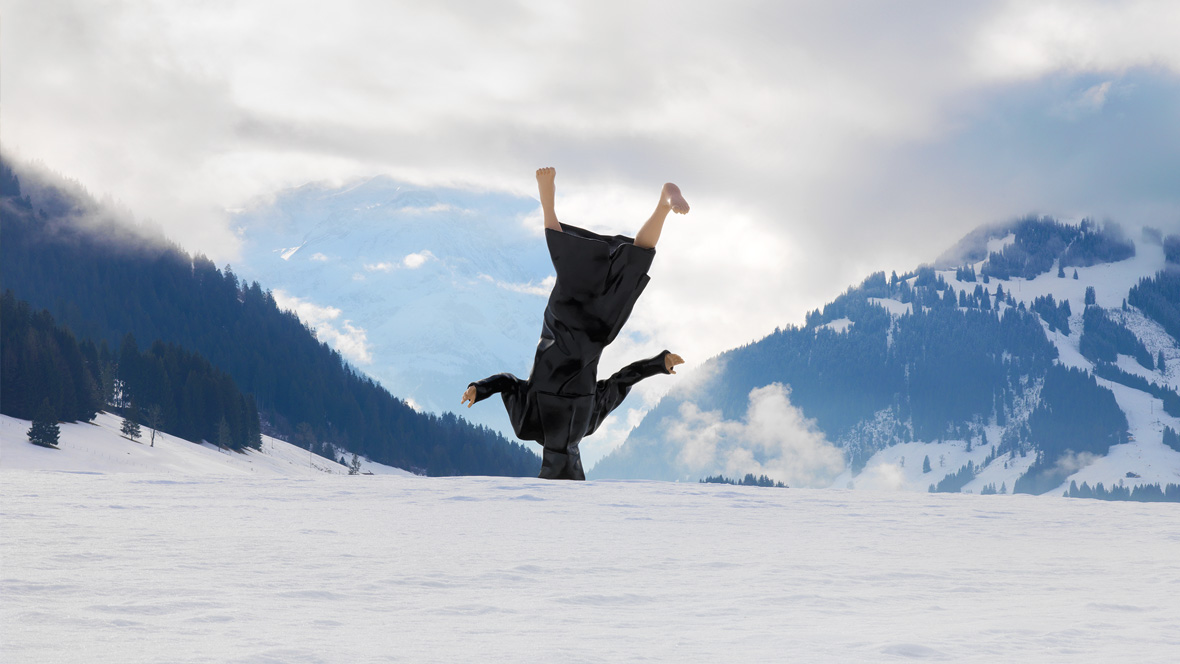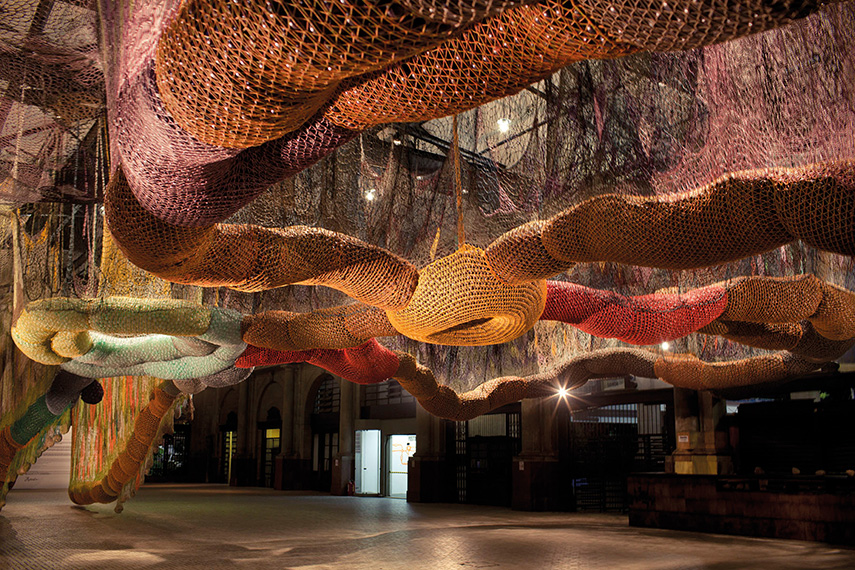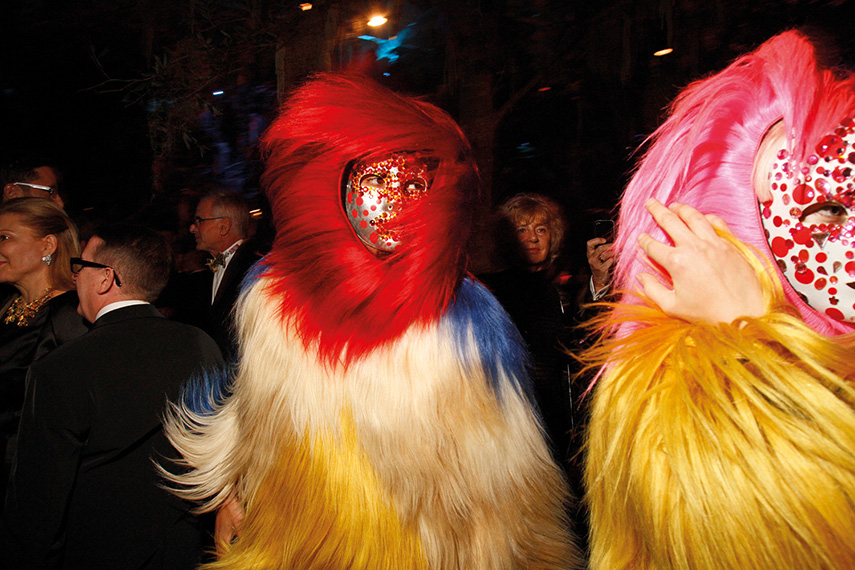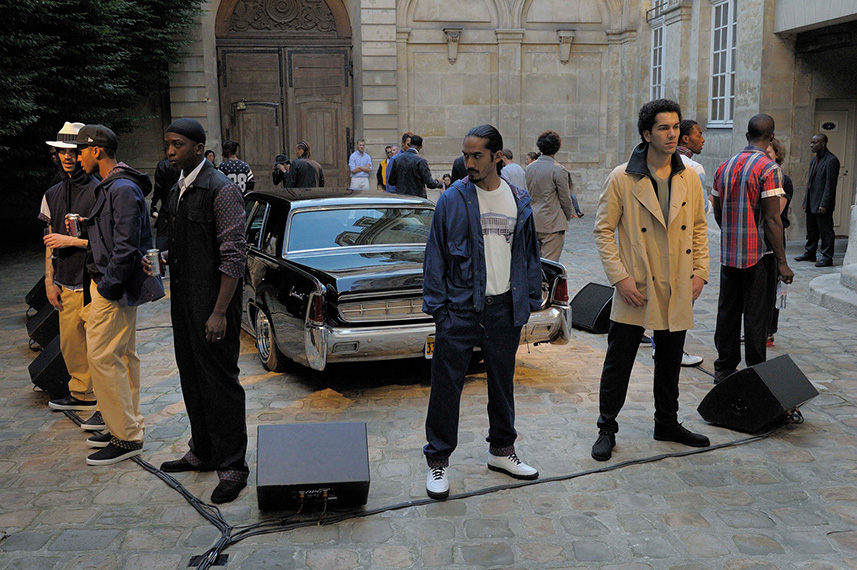
Andrew Hale in conversation with writer, curator and commentator Neville Wakefield
Neville Wakefield weighs in on heading beyond the gallery (or not); the state of contextual challenging – and why for today’s artists, social media is like venturing into the American West.

Desert X installation view of Doug Aitken, Mirage, 2017, photography by Lance Gerber, courtesy the artist and Desert X.
Working in curation, creation and text, Neville Wakefield is a master at spinning plates, both enabling culture and dissecting it, all with envied independence. Wakefield’s book Postmodernism: The Twilight of the Real, published in 1988, was his thesis on cultural history, written while he was at the Royal College of Art. Since then he has realised books about ’90s fashion photography, Ed Ruscha and Matthew Barney; contributed to magazines across the board from Artforum to Art in America, via the Vogues and agenda-setting style press, as well as curating for the Mary Boone Gallery, Frieze Projects and MoMA’s PS1, the latter with the title of Senior Curatorial Adviser. But this is scratching the surface – as the landing page on his website says: ‘don’t ask’. Which means Wakefield has something of the figurative Karl Lagerfeld about him in not resting on past accolades, carrying on while projects go off like fireworks around him. Like placing Christopher Wool and Richard Prince on Supreme skateboard decks.
In 2017, Wakefield became Art Director of ‘Desert X’, a site-specific project that continues a tradition of how art behaves outside of institutional walls. As curator, Neville’s boundary breaking role is not just to create and encourage new conditions under which art can flourish but to make it accessible to wider audiences in new and exciting ways. Taking in the desert’s abstraction, crude survival, mystery and transformation, the land’s inhospitality paradoxically makes it receptive to new forms.

Adam Kimmel’s A/W 2010 “Casino Collection” Inspired by George Condo.
Andrew Hale:
Is it fair to say that – in much of your curatorial work – there seems to be a common theme of placing an artist in an unfamiliar situation. Is there an element of wilfulness in doing that?
Neville Wakefield:
I don’t think it’s necessarily about wilfulness – I think it’s more about a shift in curating. Traditionally, curating has been about a certain kind of connoisseurship and narration… You know, finding narratives that run between images and objects, that describe the connective lineage between one work and the next. And I think the kind that I’m interested in is a contextual form of curation, one where you’re taking ideas that have visual form – thought made manifest – and creating a context that then allows for a different kind of approach, a different light of understanding and perhaps an alternative history.
And I think actually that that goes back to the project that we did together, Destricted, which was really taking an art approach to film, and reframing it in this context and history of pornography. And seeing how you can challenge perceptions I guess. Is that a fair description?
AH: Absolutely. Can we talk some more about these unfamiliar situations? Obviously, with Destricted it was contextual but I think it’s something that you’ve done incredibly successfully in terms of sense of place. Could you tell us a bit more about the thought behind the ‘Elevation 1049’ project in Switzerland and also ‘Desert X’ around Palm Springs?
NW: I think the first thing to say is that that whole interest in site-specificity comes from my interest in works that were taking place mainly in America, mainly in the American West, in the late ’60s and early ’70s, works which provided an actual as well as cultural context to those spaces and times. As we all know it was a time when artists were chafing against the confines of the gallery, trying to find new ways of creating art in the so-called ‘expanded field’, and I think there were probably two main motivations to that. One was that it was anti-institutional; in the sense that it expressed a desire to create art that existed outside of the confines of the institution. But I think it was also anti-commercial in some way. I mean if you think about those great early so-called ‘earth works’; one of the things that distinguished them, apart from them being outside, was that they were extremely difficult not just to maintain but to own. And so they kind of challenged the containerment of the art world, if you want…
AH: Yeah, and actually the whole notion of what is an artwork itself, really.
NW: Well, exactly. I think I’ve picked up on some of that, and… you know, I’m interested in the way that art behaves out-of-bounds, when it’s removed from the traditional context. And I think that’s partly about finding or rather constituting new audiences, which goes back to Destricted – crossover audiences.
AH: That was very much our thinking, we felt that – I think I did phrase it wrongly in saying wilful – it’s not actually about trying to make an artist feel uncomfortable, but about an attempt to find a way in which he or she can express themselves outside of those gallery wall boundaries, isn’t it? Destricted seemed to be – because of pornography’s relationship to film – an obvious place to look.
NW: I mean there has been so much talk about the permeability of all of these borders – whether it’s between fashion and art, or art and film; all this kind of stuff. But while there has been a lot of talk of that, actually the institutions remain pretty rigid.
So you know, I think those migrations are always interesting. And I think projects, like Destricted, encouraged that – or even to some extent the site-specific projects that I’m involved in, ‘Elevation’ and ‘Desert X’ – are attempts to manifest that thought. And while the thought is very commonplace, the manifestations are actually less so.
AH: Why do you think there has been an increase in this permeability? Do you think there’s a genuine sense of – particularly with younger artists – feeling that those worlds are more appropriate to be involved in?

Ernesto Neto, Nike’s Flyknit Collective, 2012, Rio
NW: I think no one wants to be contained. And I think, interestingly enough, as the art world has grown and expanded into this sort of art industrial complex – with shows, fairs, biennials and stuff happening all the time – the demands on artists to feed that complex have also become greater. It’s a lot of pressure to produce. And so alongside that, I think there has been a desire to find alternative outlets. In other words as the structure of the art world becomes more defined, I think the impulse to find alternative expression becomes greater.
AH: And do you think that’s because in a way, the production of art within what were seen as its original confines, now just appears to be more like the mill – and that actually artists are sort of annoyed about that incessant request for production?
NW: Yeah, I think the demands on artists are pretty punitive at this point. And at a structural level you’ve seen this convergence of art and luxury – that LVMH and the auction houses, and all these bodies – are coming under singular, parent umbrellas. So in that sense, at a financial level, at the top there has been a melding.
And at a structural level, there has been a sort of similar thing going on. If you look at the art calendar, it has become more like the fashion calendar; it’s now winter, resort, spring, summer and so on. And it goes on and on.
AH: But I think there’s also a perception from artists that those worlds aren’t… And I know as a musician, that we, certainly earlier in our career, wouldn’t be seen dead somehow sullying our name with any kind of commercial involvement. But it feels almost the opposite now – that actually it feels subversive to be collaborating with say a fashion house, in a way that that wouldn’t have happened 20 years ago.
NW: I think that’s true and it may be coming out of that a little bit now. It may be coming full circle a little bit. For instance the collaborations I do with Supreme – for their decks – and how initially it was interesting because it was this coming together of essentially high art and a street wear label. But now, as Supreme grows, and has become fairly mainstream – and perceived to be its own version of high end – then the kind of friction between the two is lessened. And with it, I think it becomes less interesting actually.
AH: I guess a certain kind of cynicism sets in; that it’s just using that language in order to actually promote something else.
NW: Exactly, it becomes co-branding; where you’re just bringing two things together, rather than a contextual challenging, which I think it started out as. So I think although yes, there has been a subversive aspect to fucking around between church and state and crossing the divide, we may be now entering a period where people are pulling back from that. At least in the commercial domain.
AH: Is it pushing it too far, thinking about that kind of hybrid world, in a post-digital sense? It feels like it’s producing a new type of artist whose work is really only about these kind of hybrid areas.
NW: Yeah, and I think certainly social media has had an effect on that. I mean that has become a whole other landscape to inhabit. Possibly going back to artists in the ’60s and ’70s being compelled to go out into what was essentially unchartered territory – the American West. A version of that, and equally wild, may now be in the digital space. In both cases the territory creates its own kind of art – its own kind of site-specificity, if you want. In this sense the digisphere has all the same kind of pioneer mythology that trails other frontiers, the American West and even the idea of art itself.
AH: So you’re saying you’re achieving the same thing, making it difficult to buy, having to engage on different levels? It’s somehow a refuge for an artist from the rigour and confines of the art world again.
NW: Exactly. And that’s the new unchartered space, where ideas, thoughts can be equally manifested either in this physical landscape, which is distant from its traditional home, the gallery; or in this digital landscape, which is equally distant.
AH: The common thread of all this – and I guess where your interest continues to lie – however these artworks are expressed, in whatever medium or whatever geographical or virtual space, it really is about – as all great art should be – producing something that would not have been produced otherwise; or asking questions that may not have been asked otherwise. Which is probably why artists are looking in that place!
NW: Yeah, I think so. And coming from writing to curating, I think curating is in some ways writing by other means. It’s all about the conversation; art exists in conversation. It doesn’t exist in isolation. In some ways the challenge of the curator, as much as the artist, is to create the most interesting frame for that. And that may be inside the gallery, or it may be outside the gallery – depending on the type of work, the type of conditions, and the moment in history.
AH: What role does the gallery play in today’s atomised art world, or culture?

Van Cleef & Arpels, “Mirror Ball” Gala, 2011, Miami
NW: I think it plays an essential role. I don’t think that the sort of site-specificity that interests me, the non-gallery approach, is incompatible with the gallery approach. I think they’re two different sides to the same thing. Like Robert Smithson’s site / non-site dialectic, the one is dependent on the other.
It’s interesting the experience of a curator is very different from the experience of a typical art consumer. Because as a curator you go into a studio, you see work being made amid all this noise of its production. And then you extract it, and put it in a white cube where it would exist in its moment of celebratory isolation away from all the noise of its production. The other side of that, and what interests me about the site-specific approach, is that the ‘noise’ is part of the piece.
AH: Sure.
NW: So where landscape for instance becomes generative – and by landscape I mean not just the actual landscape but social, historical, all the rest of it – in a genuine site-specific work, the landscape effectively is the studio. So you’re seeing the conditions under which the work was produced. I think that has a virtue because it allows people who don’t know a lot about art to approach it through the thing they do know about, which is the conditions – the landscape, the social… you know, the history, all the rest of it. So they’re two very different approaches. Whereas you go into a white cube space, and you’re asked to drop all preconceptions and focus on art historical knowledge, because that’s the only context you have. It’s two very different sorts of audiences.
AH: The power of the white cube, at least for an artist, continues to be a space where a primary work is shown in the conditions in which the artist wishes for it to be seen for the first time. And that is something now that cannot happen anywhere else – with all this increasing noise of fairs, and biennials, and all that other stuff. Maybe the noise is sometimes unwanted?
NW: Yeah, exactly. I mean I think there are two poles. One is a type of art practice where the noise is part of the production and part of the conversation. And the other, which is equally important and relevant, is where the noise needs to be subtracted from it. And the object, or entity, is celebrated in its, as it were, pure state.
My approach, my interest, is in the sort of operatic type – more operatic impurities surround art. But that doesn’t mean to say that doesn’t invalidate the pure approach, which is the isolationist approach that is founded in this idea of the white cube.
AH: Of course this is also tied up in the changing business of art and the interplay between institutions, galleries, artists, collectors and sponsors. You mentioned in the recent piece you did with Artnet about Nike being the new Medici.
NW: (Laughs). Sorry, that was so embarrassing. It was a slip of the tongue!

Adam Kimmel, Spring 2011 Menswear, 2010, Paris
AH: (Laughs). But there is a serious point there about notions of patronage, which again is to do with contemporary culture and the way that work is commissioned and paid for. I guess that’s another area that you’re constantly engaging with?
NW: I mean when I said that Nike is the new Medici, I was a little bit tongue in cheek. But I think what I’m really saying is that, in terms of corporate incursion into the art experience, I don’t see a huge difference between Dior sponsoring the Christopher Wool show at the Guggenheim and Nike asking artists to create works that service product launch and activation.
AH: And I think that can be interesting in itself.
NW: In other words, if you believe that this kind of commercialism somehow contaminates the process or the understanding, then that’s got to be equally true now of museums, which are so dependent on this kind of patronage. I think that’s what I was trying to get at.
When asked about the irony of pop art hi-browing low-brow commercialism, Ed Ruscha famously resounded, “Well how can you sell with out selling out?” The question and answer were both intended to be rhetorical but if you really tried to respond, the answer might be you can’t. And maybe that’s the middle-brow position we seem to be taking.


